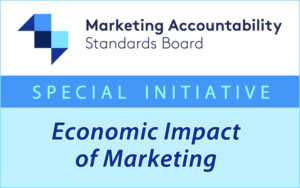 WHY THIS IS A PRIORITY
WHY THIS IS A PRIORITY
The Marketing Accountability Standards Board (MASB) was founded on the initiative of the major marketing associations. Why? Because they felt there was a critical need to increase the credibility and elevate the role of Marketing by demonstrating its economic impact. In today’s environment of geopolitical and economic uncertainty, this need is greater than ever. It was voted top priority by the MASB Marketing Association Alliance, and in recent board meetings of the ANA CMO Council, it was raised as a major gap in marketing capability.
THE OPPORTUNITY
Marketing is the driver of the demand chain. It’s what brings in the money and produces growth, – a CEOs’ top priority. Yet its importance is still not recognized. Marketers are the executives that CEOs need the most but trust the least. While 90% of CEOs trust their CFOs and CTOs, 80% do not trust their CMOs.
Though marketers’ costs are very visible, their impact on revenues and profits is not. As a result, they struggle to get the investment they need and then sustain it. The old story that marketing costs are seen as frivolous and therefore are the first to be slashed in a recession is unfortunately still true. Marketers are forced to prioritize efficiency of spend over effectiveness, short term over long term, and short-term “performance marketing” over longer term marketing and brand building. The result is lack of traction and an inability to leverage prior investment, leading to sub-optimal results.
Due to the predominance of non-financial metrics over those that must be reported (e.g. cash flow), Marketing’s true impact is not understood. This won’t change until marketers are able to speak the language of Finance and demonstrate the financial business impact of what they do in terms that non-financial executives and board members regard as robust.
This is why MASB was set up—to create the missing link between Marketing and Finance and make it possible to prove the financial value of what marketers do with robust facts and figures.
WHAT WE PLAN TO DO
We are putting together a team of Marketing and Finance practitioners, measurement agencies and academic experts to create a new initiative to build on the very substantial intellectual property base that MASB has produced through its participation in the development of ISO standards as well as its Financial Value of Brands, Continuous Improvement in Return and other initiatives.
The new team’s objectives will be to:
- Design and implement a best practices approach to measuring the economic impact of Brand and Marketing.
- Prove that the only way to drive sustainable business growth is investment in Brand and Marketing – along with the innovations identified by Marketing as future customers’ greatest needs.
- Substantiate this by producing robust evidence of the incremental financial results that this type of investment produces, presented in CEO and CFO language.
- Show that the need to maintain marketing spend during a downturn is critical and quantify the economic impact of retaining, increasing, or cutting investment.
- Identify the principles that companies should follow to maximize the business impact of marketing by spending marketing budgets most wisely.
- Recommend the processes and metrics companies should use to accurately track marketing’s financial impact.
- Publish measurement standards for Marketing equivalent to the standards that exist for Financial Management. These principles should not be unduly prescriptive but will ensure quality of measurement.
- Make available independent, third-party verification and certification of measurement predictive of financial returns, so MASB lives up to its original charge of being the Marketing equivalent of FASB and SASB.
WORKSTREAM STRUCTURE – Initial Thoughts
1. Assemble the right team.
Recruit three companies to participate; ideally one pure B2C, one with a two-sided model for consumers and business customers, and one purely B2B. Request engagement from Marketing, Finance and Insights within each. Partner company team members with academic experts (starting with established MASB specialists) and data providers (with agencies to be determined by each company’s industry verticals and current suppliers). Depending on the agreed-upon depth of analysis, involvement by accredited third parties may also be required.
2. Coalesce the foundational IP.
The academic and measurement agency team members will review and summarize relevant data, case studies and findings from MASB and prior third-party work. This will enable us to define what is known and identify major gaps.
3. Obtain relevant data from the three participating companies.
This will include financial, customer, and marketing investment data, historical and projected.
4. Identify relevant instances to measure.
For example, measure periods where marketing budgets were significantly increased or reduced, when major changes were made in allocation, or when marketing investment levels diverged from market and competitor norms, pre-, during and post-recessionary periods.
5. Design and run Marketing Economic Impact Model
Following the best practices principles established in prior MASB studies, measure the economic impact of the different instances.
6. Establish principles and metrics for measurement.
Identify key indicators from the exercise, recommend what principles marketers should follow to demonstrate marketing’s economic impact and what metrics best measure the results.
PARTICIPATE!
Marketing and Finance practitioners: Join with us to transform Marketing’s role and recognition while accelerating your company’s growth by implementing best practices in marketing measurement and accountability.
To schedule a meeting to discuss participation, please contact MASB Executive Director Frank Findley, frankfindley@themasb.org.
